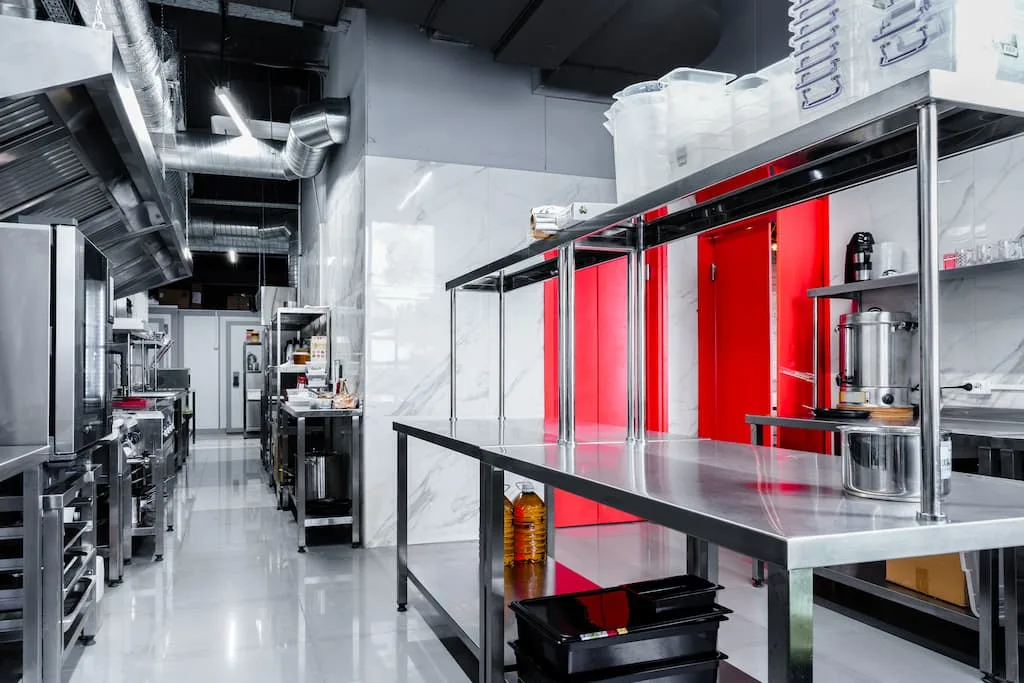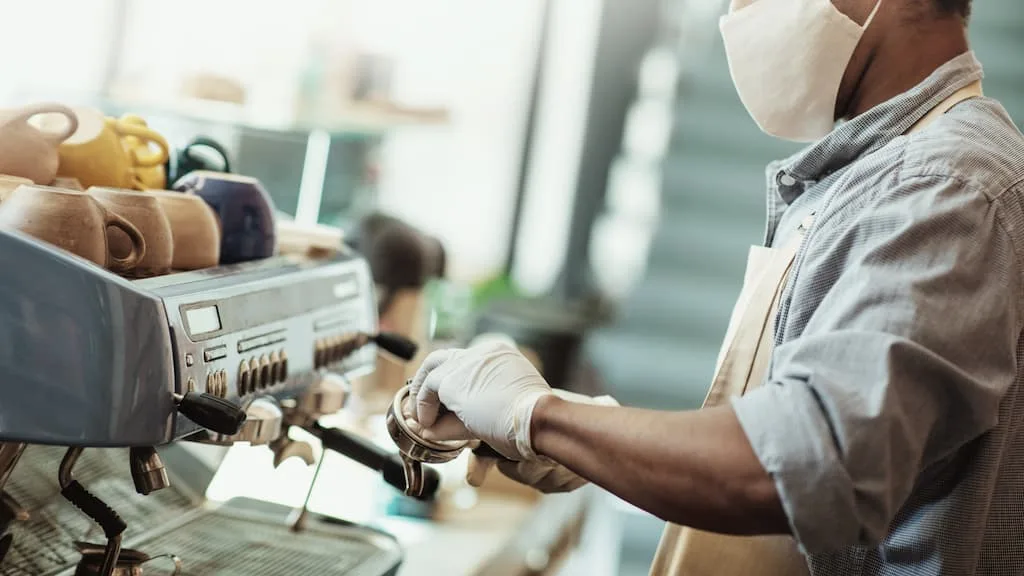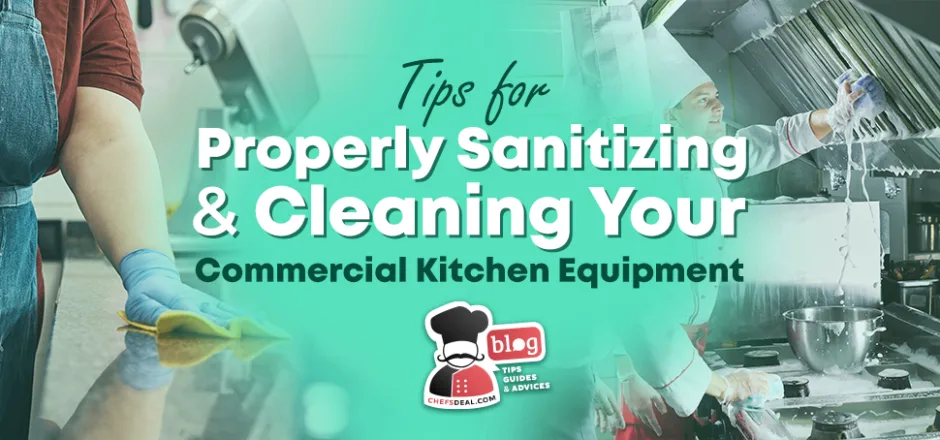Cleaning commercial kitchen equipment is the key to ensuring the longevity of your investments and the health of your staff and customers. There are easy guidelines you can integrate into your schedule to maintain a spotless kitchen. By following these guidelines and making small changes in your operations, you can easily sanitize and clean your commercial equipment. In this article, we will explore the importance of cleaning and sanitizing and provide you with five essential steps for effective cleaning and sanitizing.
The Difference Between Sanitizing and Cleaning Commercial Kitchen Equipment
Cleaning and sanitizing are often used interchangeably in conversation, but they are different. Cleaning refers to removing dust and dirt from surfaces while sanitizing refers to a deeper cleaning method that aims to remove bacteria from the object. They are both necessary to maintain a healthy environment for food prep.
5 Steps for Effective Cleaning and Sanitizing
You can follow four easy steps for sanitizing and cleaning commercial kitchen equipment. By following these tips, you can ensure a good cleaning program in your kitchen.
1. Establish a Cleaning Schedule: You need a schedule to keep track of your cleaning needs. Each piece of equipment will need cleaning and sanitization at different intervals. By making a schedule based on these and dividing the labor among your staff, you can ensure that nothing escapes your attention.
2. Use the Right Cleaning Products: Cleaning commercial kitchen equipment is crucial to preventing health hazards. However, not using the right cleaning products creates health hazards. Ensure that the products are safe for kitchen environments, and label your cleaning equipment based on their area of use. You shouldn’t cross-use a mop used in the toilet to clean the floors of your walk-in freezer, and you shouldn’t use chemicals meant for harder surfaces or drains on kitchen utensils.
3. Focus on High-Touch Surfaces: High-touch surfaces such as counters, light switches, and handles are touched frequently throughout the day. You should clean these surfaces several times a day since many germs can culminate in such areas. They should be wiped at least twice a day and deep cleaned once every day. Counters should be cleaned more frequently since it comes into contact with food more often. Disinfecting these areas will decrease the likelihood of bacteria growth and spread.
4. Disinfect with Proper Techniques: This step focuses on addressing specific challenges that arise from daily use, such as removing stubborn grease and grime, eliminating rust and mineral build-up, and dealing with food stains and discoloration.
To tackle grease and grime, it’s essential to use degreasers specifically formulated for kitchen surfaces. These powerful agents help dissolve and lift stubborn grease, making it easier to wipe away. Specialized cleaning solutions containing rust inhibitors can be highly effective when combating rust and mineral build-up. These solutions break down rust and mineral deposits, restoring the equipment’s functionality and appearance.
Food stains and discoloration can be particularly unsightly, but with the right techniques, they can be effectively treated. For tackling stains, it’s important to use appropriate stain removers that are safe for use in food preparation areas. These removers should be applied following the manufacturer’s instructions, allowing sufficient contact time to break down and lift the stains. Additionally, regular deep cleaning and polishing can help prevent and minimize the appearance of stains and discoloration, ensuring your equipment maintains a clean and professional look.
5. Pay Attention to the Condition of Your Equipment: Be careful with the condition of your equipment or occasionally inspect your products with an inspection checklist. This way, you can spot issues before they become massive problems and get ahead of the crisis. Common signs include dust, spillage, mold, uncommon noises, overheating, clogging, frost, underperforming functions, and more.
Other Key Considerations for Sanitizing and Cleaning Commercial Kitchen Equipment
There are 3 other key points you shouldn’t forget while sanitizing and cleaning commercial kitchen equipment.
- Personal protective equipment (PPE) for staff is a must-have. Cleaning and sanitizing products contain chemicals, and avoiding physical contact with such products is best. Gloves, bonnets, goggles, and aprons can be a good start to protect your staff. Such measures will also ensure that your team does not contaminate the food.
- Training for staff on cleaning and sanitizing procedures is crucial when it comes to commercial kitchen equipment. Each piece has a unique cleaning need, and your team needs to be well-informed regarding these requirements and how the machine can be safely dissembled and reassembled for the cleaning process.
- Maintenance and Inspection: You should conduct periodically for each kitchen piece of equipment. Maintenance schedules might require a professional touch. Find a reliable service provider and schedule periodic maintenance for bigger machines such as walk-ins and exhaust hoods.

How Often Should You Clean Your Commercial Kitchen Equipment?
The intervals of cleaning and sanitizing for each piece of equipment can differ. Cooking utensils will need to be cleaned after each use, while larger equipment, such as walk-in refrigerators, are encouraged to be deep-cleaned once every three months. To find out how often you should clean specific equipment, you can consult your dealer or the maintenance guidelines of the equipment. If you can’t get an answer from these sources, take into consideration the following to get a rough idea of its cleaning needs:
- How often the equipment in question is used? If the equipment is used frequently, it’ll need frequent cleaning.
- What kind of products does it come into contact with? Coffee machines will have coffee machine cleaners, and deep fryers will need degreasers. By knowing what your machine deals with, you can target the right elements and get an idea about the necessary cleaning intervals to prevent the culmination of particles.
- Is there any spillage or dripping in/on it?
- Do you use the equipment with different products that might lead to cross-contamination of allergens? To create an allergen-free environment, you should be wary of cross-contamination and keep track of which equipment is used with what.
Which Equipment Needs the Most Attention to Clean and Sanitize?
While the kitchen should be spotless in general, the following pieces of equipment carry most of the burden during cooking, storing, and serving. You need to ensure they are in good condition before using them.
- Food Prep Equipment comes in contact with the food at every preparation stage. To avoid health hazards, you must ensure everything is clean, from the counter to the pot. Prep tables, kitchen counters, pots, pans, cooking utensils, and cutting boards are all included under this title.
- Ovens and stovetops are heavily included in the cooking and baking process. These stations are where the magic happens. Due to their heavy use on a business day, these pieces will require your special attention. Stoves and ovens can collect grease, food remnants, and dust. Make sure to clean any spilled food immediately and sanitize these surfaces regularly. If you wipe the surfaces after every use, once a week, careful cleaning should be enough to keep these areas in good condition.
- Refrigerators and freezers are used for storage purposes. Every ingredient in the kitchen comes into contact with these two spaces, and cleaning commercial kitchen equipment is crucial in such scenarios.
You should wipe these units’ walls and shelves weekly and check your inventory regularly to eliminate ingredients that might rot or gather mold soon. Deep-cleaning once every four months or so is usually a good idea. You should also defrost your freezer once a year and deep clean it if it’s not a self-defrosting model. Frost formation in the freezer can damage the machine, and the captured humidity and particles in the ice can endanger your products’ health and smell.
- Beverage equipment, such as coffee machines, soda dispensers, and blenders, often come into contact with various liquids and ingredients, creating an environment where bacteria, mold, and yeast can thrive if not properly maintained. Additionally, beverage equipment is frequently used throughout the day, increasing the risk of residue buildup and contamination.
Regular cleaning and sanitizing of beverage equipment are essential to prevent the growth of harmful microorganisms and ensure the safety and quality of the beverages served. Neglecting the cleaning and sanitizing of beverage equipment can not only compromise the taste and quality of drinks but also pose health risks to customers. Therefore, it is crucial to follow the manufacturer’s guidelines and establish a regular cleaning schedule to maintain the cleanliness and hygiene of beverage equipment in a commercial kitchen.

- Sinks and dishwashers are other equipment that needs cleaning and sanitization deeply. While these two areas are constantly in contact with water and utilized for cleaning purposes, it shouldn’t be overlooked that they are tasked with removing dirt from other things and can get overloaded with bacteria. You should disinfect the surface of your sink once a week on top of daily run-downs with soap.
When cleaning commercial kitchen equipment, you should always remember the drains. Dishwasher and sink drains can clog over time due to collecting food remnants and dirt. To prevent that from happening altogether, clean your drains and pipes regularly. For the commercial dishwashers, you can take extra measures such as running them empty monthly with dishwasher cleaners. This will clear the build-up in the machine and ensure the dishwasher cleans your dishes as it should.
- Small appliances and utensils should be cleaned after each use. Use a dishwasher for the best results. You can invest in stainless steel utensils as they are quite bacteria-resistant.
FAQs About Cleaning Commercial Kitchen Equipment
1. Can I use bleach to sanitize my equipment?
Bleach is not the best product for sanitizing kitchen equipment. While it is a great disinfectant for removing stains, it is not a food-safe product and can affect stainless steel surfaces poorly.
2. What are the consequences of not properly cleaning and sanitizing equipment?
There are 3 main consequences of not properly cleaning commercial kitchen equipment. Unclean equipment endangers the health of your staff and customers, decreases the longevity of the equipment, and leads you to fail health inspections.
3. Do I need to hire a professional cleaning service?
It depends on your equipment size, your personal cleaning allocation, and time separation. Most machines are quite big and require the dissembling of certain pieces for maintenance. While a well-trained staff can handle this, you can also employ the help of professional cleaners periodically to ensure everything is spotless and handled professionally.
4-What cleaning products should I use?

Buying machine-specific cleaners such as fryers, ovens, ice machine cleaners, and similar products can make your job a lot easier. If you are looking to buy general cleaners for surfaces and pieces of equipment that don’t have special cleaners, look for mild and food-safe labels on the packaging. These tags indicate that the cleaner is safe to use in a kitchen environment and won’t abbreviate the stainless steel surfaces in the kitchen. Also, ensure you have degreasers, hand soaps, and surface cleaners.
Conclusion
Cleaning commercial kitchen equipment is an important task. You should train your staff and establish a cleaning/sanitizing schedule for each and every machinery and surface in your kitchen. While every aspect of a commercial kitchen will have different needs, keeping tabs on the condition of your kitchen is a manageable task with the right planning and information. By utilizing the tips shared here and doing a deeper dive into what specific pieces of equipment might need, you can stay ahead of the problems and pass health inspections.






